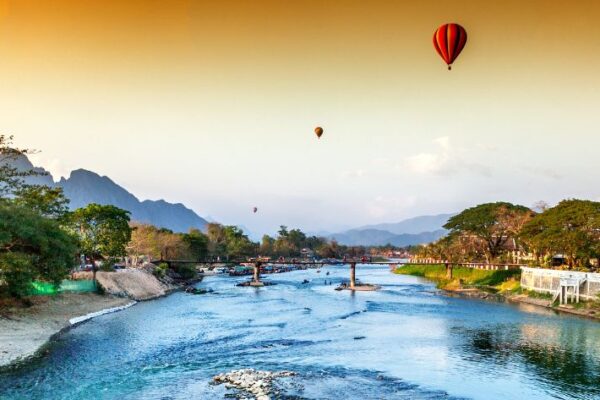Explore These 14 Vietnam Historical Landmarks To Learn About The Country’s Intriguing Past
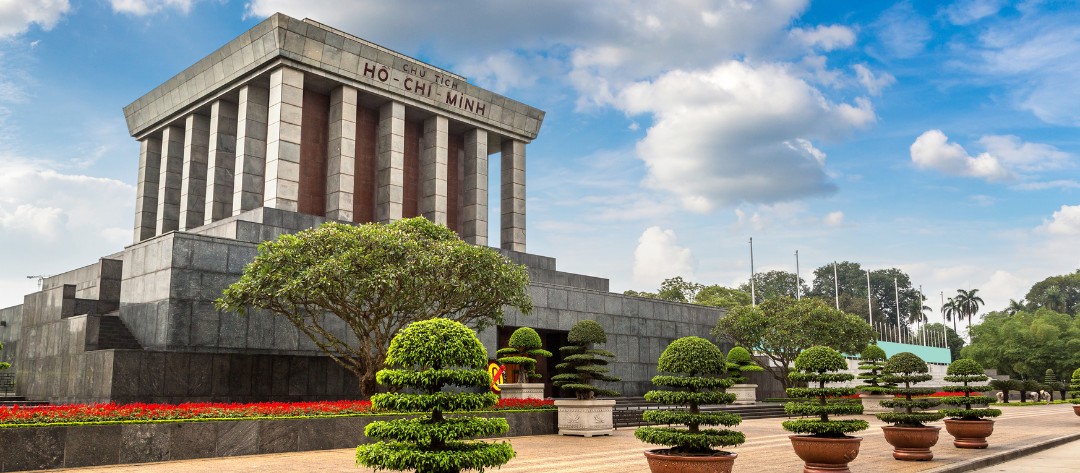
A visit to Vietnam is incomplete without exploring its rich history, which is best done by visiting its historical landmarks. Each site tells a story of Vietnam’s complex history, conflicts, and culture. These milestones range from ancient citadels that speak of dynastic rule to poignant reminders of war and resilience, offering a profound glimpse into the soul of this vibrant nation.
In this article, we will take you on a journey through time as we reveal 14 must-visit Vietnam historical landmarks that every traveler should include in their itinerary.
Vietnam’s Ancient History
Vietnam’s history is a saga of resilience, rich cultural heritage, and transformation, a narrative that spans thousands of years and is as diverse as its landscape. The history of this indomitable nation can be broadly categorized into two significant periods.
Vietnam’s ancient history is known as the cradle of its civilization, marked by the rise and fall of dynastic powers, the flourishing of unique cultural identities, and impressive feats of architectural ingenuity. From the first Vietnamese state of Van Lang to the emergence of the independent Dai Viet kingdom, this period is a mosaic of battles for autonomy, cultural assimilation, and the establishment of a deeply-rooted Vietnamese identity.
It was during this era that iconic structures like the Thang Long Imperial Citadel, a UNESCO heritage, were constructed, which stand today as testaments to the country’s rich dynastic past.

The Flag Tower of Hanoi, a part of the Thang Long Imperial Citadel
Recent Modern Records
The modern era of Vietnam’s history is marked by its fight against colonialism, the long-lasting effects of wars, and the country’s continuous effort toward industrialization and modernization. This period is characterized by French colonial architecture, remnants of wars, and places significant to political history.
It is a period that reflects the resilience of the Vietnamese spirit, seen in landmarks such as the Hoa Lo Prison and the Reunification Palace. The modern period also underscores the nation’s path to healing and growth, with sites like the War Remnant Museum and Cu Chi Tunnels providing powerful insights into the complexities of Vietnam’s recent past.
Vietnam’s historical landmarks are the pillars that support the narrative of a nation’s journey through the ages. They are the keepers of stories, both triumphant and tragic, and visiting them offers a deeper understanding of not just the country’s history but also its collective consciousness.
14 Must-visit Vietnam Historical Landmarks For All Travelers
Thang Long Imperial Citadel
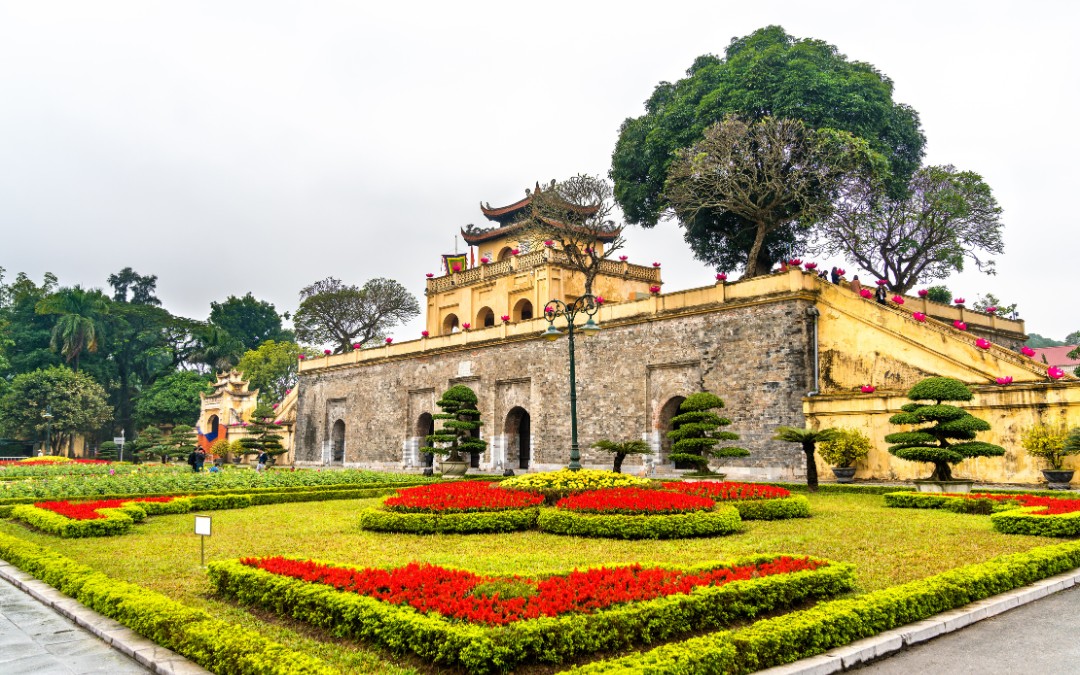
The Doan Mon Gate of Thang Long Imperial Citadel
In the heart of Hanoi lies the Thang Long Imperial Citadel, a historic complex of royal monuments and ruins dating back to the 11th century. It served as the country’s political hub for over a millennium. The citadel’s cultural layers represent the synergy of indigenous and foreign influences, particularly Chinese and French, which have shaped Vietnamese history.
Visitors can explore the Doan Mon Gate, the Flag Tower, Kinh Thien Palace’s foundations, and the D67 Tunnel and House, where pivotal military decisions were made during the Vietnam War. Its excavation site, revealing ancient palaces and artifacts, offers an unparalleled glimpse into Vietnam’s dynastic past.
President Ho Chi Minh Mausoleum
The President Ho Chi Minh Mausoleum is not only an architectural feat but also a symbol of Vietnamese reverence for their most celebrated leader. Located in Ba Dinh Square, this grand edifice houses the embalmed body of Ho Chi Minh, visible to visitors in a solemn atmosphere.
The surrounding complex includes the Presidential Palace, Ho Chi Minh’s stilt house where he lived and worked, and the One Pillar Pagoda, reflecting his modesty and Vietnam’s cultural heritage. The mausoleum’s design, with its grey granite façade and socialist realist sculptures, stands as a monument to the legacy of ‘Uncle Ho’ and the aspirations of the Vietnamese people.
Hoa Lo Prison
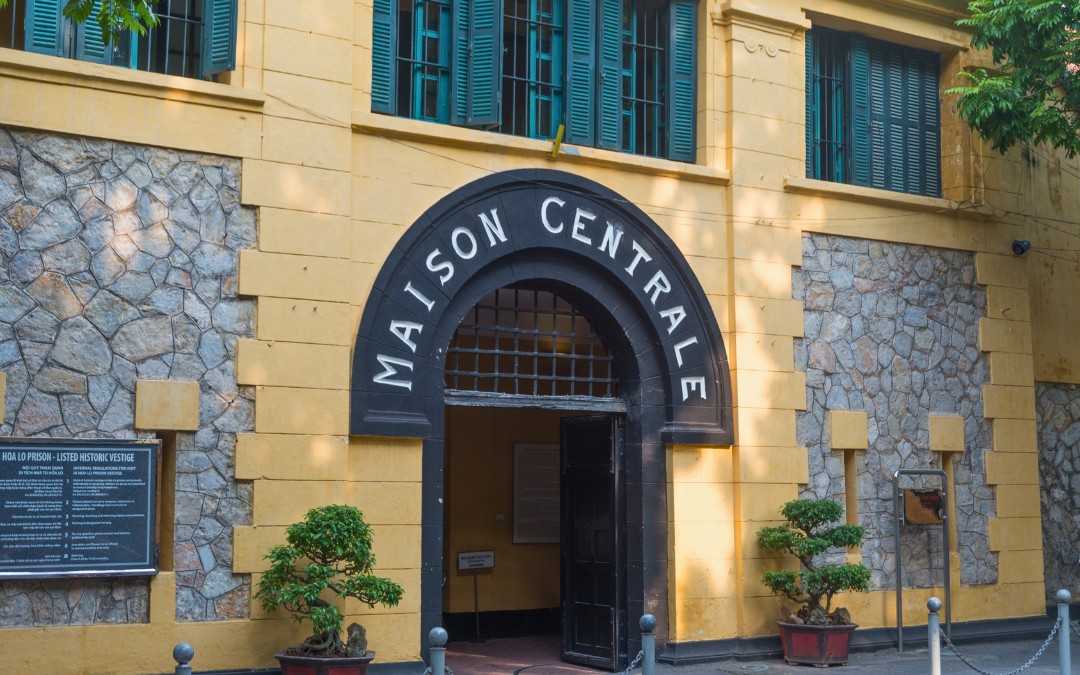
Entrance to the Hoa Lo Prison
Hoa Lo Prison, infamously known as the “Hanoi Hilton,” holds a dark yet pivotal part of Vietnam’s history. Originally built by the French colonists for political prisoners, it later became a prison for American pilots captured during the Vietnam War.
Today, it serves as a museum where the stories of the inmates’ resistance and resilience are displayed. As visitors walk through the cramped cells and view the original French guillotine, the site evokes a profound sense of the struggle for Vietnamese independence and the complexities of human endurance.
Trang An Complex
The Trang An Complex, nestled amidst majestic limestone karsts and winding rivers, offers a spectacular tableau of natural beauty intertwined with historical significance. This UNESCO World Heritage site encapsulates Vietnam’s ancient and medieval past, housing the old capital of Hoa Lu and venerable temples such as Bai Dinh.
A boat journey through its caves and waterways reveals hidden shrines and a serene landscape that has inspired countless legends. As a testament to human ingenuity adapting to nature’s canvas, Trang An stands as a harmonious blend of Vietnam’s history and its timeless natural wonders.
Hue Imperial Citadel
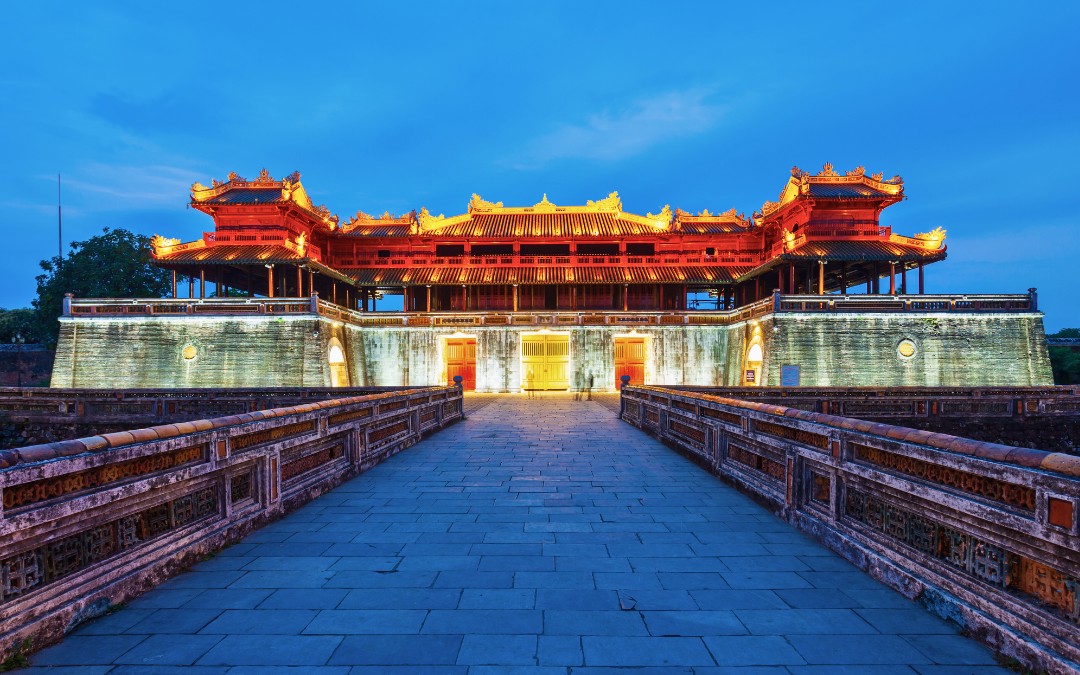
Night view of Hue Imperial Citadel
The Hue Imperial Citadel is a grandiose remnant of Vietnam’s last royal dynasty, the Nguyen Emperors. This vast complex, also a UNESCO World Heritage site, features imposing gates, ornate pavilions, and tranquil gardens, all enclosed within formidable stone walls.
Despite being heavily battered during the Tet Offensive of 1968, the citadel’s Forbidden Purple City, and the Ngo Mon Gate still evoke the opulence of a bygone era. Restoration initiatives continue to revive its historical splendor, allowing visitors to step back in time and experience the architectural and cultural majesty of Vietnam’s feudal heritage.
>> See Tour: World Heritage Sites of Vietnam
Tombs of Khai Dinh, Minh Mang, Tu Duc
The Imperial Tombs of Hue are the final resting places of the Nguyen Dynasty’s rulers, each reflecting the emperor’s personality and the architectural styles of their era.
- Khai Dinh Tomb
The tomb of Emperor Khai Dinh, who reigned from 1916 to 1925, stands as a testament to the fusion of Vietnamese and European design influences. Perched on the slopes of Chau Chu Mountain, this elaborate mausoleum took 11 years to complete. The interior is adorned with intricate mosaic murals combining glass and porcelain, which create a dazzling visual effect unique among the royal tombs.
- Minh Mang Tomb
In stark contrast, Emperor Minh Mang’s tomb is an expansive, serene complex that harmoniously blends with its natural surroundings. Completed in 1843, the site is set within lush gardens and features a symmetrical layout of courtyards, pavilions, and lakes, reflecting the emperor’s Confucian influence and contemplative nature.
- Tu Duc Tomb
The most picturesque of the imperial tombs, the resting place of Emperor Tu Duc, who reigned from 1847 to 1883, was designed to be a place of leisure and reflection during his lifetime. This sprawling complex includes a lotus-filled lake, pavilions, temples, and a small island where the emperor would compose poetry. Its tranquil atmosphere invites visitors to ponder the ephemeral nature of life and power.
My Son Sanctuary

Discover the temple ruins of the My Son Complex
The My Son Sanctuary is a series of ancient temple towers nestled in Central Vietnam’s verdant valley, a haunting echo of the Champa Kingdom’s spiritual life.
This UNESCO World Heritage site, dating from the 4th to the 13th centuries, is a remarkable example of cultural interchange, with influences from Hinduism manifested in the sandstone sculptures and carvings depicting scenes from Hindu mythology. Despite suffering extensive damage during the Vietnam War, the site remains a powerful link to Vietnam’s pre-Vietnamese culture and the ingenuity of the Champa artisans.
Quang Tri Citadel
The Quang Tri Citadel stands as a somber memory of Vietnam’s turbulent history.
Constructed in the early 19th century under the reign of Emperor Gia Long, this fortress bore witness to the fierce battles during the 1972 Easter Offensive, a pivotal moment in the Vietnam War. The citadel’s walls, though scarred by conflict, continue to speak volumes about the resilience and sacrifices of the Vietnamese people. Its significance in Vietnam’s national struggle for independence has earned it the status of a Special National Site.
Vinh Moc Tunnels
A testament to the human spirit’s unyielding will to survive, the Vinh Moc Tunnels are an underground sanctuary that once shielded an entire community during the Vietnam War’s heaviest bombings. Located near the Demilitarized Zone, this complex network housed hundreds of people and included all essential amenities, from living quarters to healthcare facilities. Remarkably, life persisted here, undeterred by the war above.
Visitors today are offered a poignant glimpse into the extraordinary conditions endured by civilians during wartime.
Reunification Palace
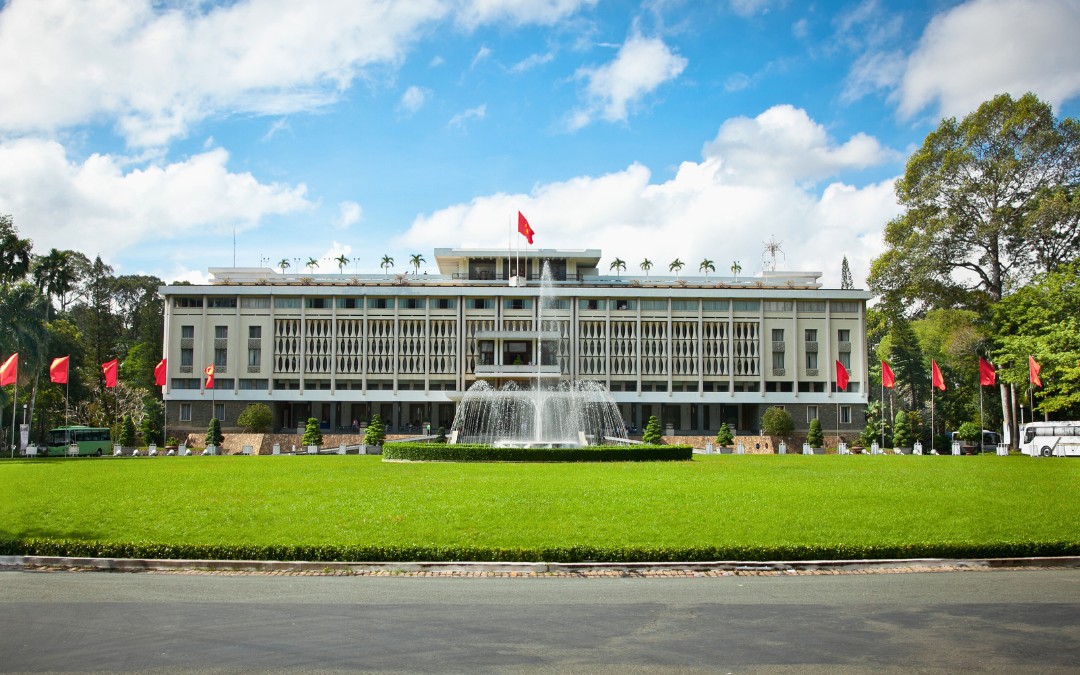
The historical landscape that marked the end of the Vietnam War
The Reunification Palace in Ho Chi Minh City, formerly known as the Independence Palace, is emblematic of the end of the Vietnam War; it was here that North Vietnamese tanks breached its gates, leading to the fall of Saigon.
Originally the residence of the South Vietnamese President, the palace is now a museum with rooms preserved as they were during that historic day in 1975. The building’s architecture and interior design reflect the 1960s era, offering insights into the lifestyle and workings of the former government. It stands as a symbol of the country’s reunification and the aspirations for a peaceful future.
War Remnants Museum
The War Remnants Museum in Ho Chi Minh City delivers a harrowing and thought-provoking narrative of the Vietnam War’s brutal impact.
Through compelling exhibits, including military equipment, photographs, and personal accounts, the museum confronts visitors with the atrocities of war and the enduring consequences faced by its victims. It stands as a stark reminder of the war’s legacy and serves as a plea for peace and understanding.
Cu Chi Tunnels
The Cu Chi Tunnels are an extensive underground network that played a crucial role in the Viet Cong’s military campaigns during the Vietnam War. Located just outside Ho Chi Minh City, this labyrinth helped to facilitate communication and coordination among troops, as well as serving as a living space for guerrilla fighters.
Today, visitors can crawl through a section of the tunnels, gaining a visceral sense of the ingenuity and resilience of the Vietnamese soldiers under trying conditions.

Explore Cu chi Tunnels with true-to-life activities
>> Read More: Cu Chi Tunnels – A Complete Guide To Vietnam’s Underground History
Phu Quoc Prison
Phu Quoc Prison, located on the serene island of Phu Quoc, paints a stark contrast between its beautiful setting and its dark past.
This former prison was used during the Vietnam War to detain and torture prisoners of war, and it is now open to the public as a museum. The site’s displays, including mannequins and graphic photographs, offer a sobering look at the harsh realities of confinement and the human capacity for both cruelty and endurance.
>> Read More: The Ultimate Phu Quoc Travel Guide
Con Dao Prison Complex
Con Dao Prison Complex symbolizes the suffering endured by countless Vietnamese patriots during the French colonial era and later the American-backed South Vietnamese regime. The prison, famous for its “tiger cages,” where prisoners were kept in inhumane conditions, is now a museum that honors the resilience of the Vietnamese spirit.
A visit to this historical landmark is a somber experience, reflecting on the sacrifices made for Vietnam’s freedom and sovereignty.
>> Read More: Con Dao – A Completed Guide To Vietnam’s Untamed Paradise
Recommendations When Visiting Vietnam Historical Landmarks

Some tips when planning for a trip to Vietnam’s historical sites
When planning a visit to these sites, consider the following recommendations to enhance your experience and show respect for the country’s heritage.
- Do your research
Before visiting, read up on the history and significance of each site. Understanding the context will enrich your experience and provide deeper insight into what you’re seeing.
- Hire local guides
Engage with local guides who can offer personal stories and historical details that might not be available in guidebooks. Their knowledge can provide a more authentic perspective on the sites.
- Respect the sites
Many historical landmarks are also memorial sites. Show respect by dressing appropriately, speaking softly, and following any posted rules or guidelines.
- Plan your visit
Some landmarks can be crowded or have limited visiting hours. Plan your itinerary to avoid peak times and check if you need to book tickets in advance.
- Be mindful of the weather
Vietnam’s climate can be hot and humid. Dress comfortably, stay hydrated, and protect yourself from the sun. Consider the seasonal weather patterns as well, such as the monsoon season, which can affect travel plans.
- Support conservation efforts
Where possible, support the preservation of these historical sites. This can be through donations, choosing responsible tour companies, or participating in preservation activities if available.
- Capture memories respectfully
While photography is usually allowed, be mindful of when and where you take photos, especially at sensitive locations. Always ask for permission before photographing people.
- Interact with respect
If you have the opportunity to speak with locals, especially those who may have lived through historical events, listen respectfully to their stories. Their personal accounts are invaluable oral histories.
- Leave no trace
Ensure that you leave the sites as you found them. Do not remove any artifacts or deface the landmarks. Littering is not only disrespectful but also harmful to these precious sites.
- Reflect on your experience
After visiting these landmarks, take time to reflect on the experiences and knowledge gained. Consider how Vietnam’s history has shaped the country today and what lessons can be learned from your visit.
Come & Visit Vietnam Historical Landmarks
Vietnam’s historical landmarks offer a profound journey through the country’s rich tapestry of history. Each site tells a story of resilience, culture, and transformation. As you explore these storied locations, take a moment to appreciate the lessons they offer and the spirit of the Vietnamese people that permeates them. Whether you’re a history buff or a curious traveler, these landmarks are sure to leave a lasting impression, enriching your understanding of Vietnam’s complex and vibrant past.
Are you ready to discover the intriguing stories of Vietnam’s past? With Asia Pioneer Travel, you can explore the diverse and fascinating history of Vietnam in depth. From the ancient dynasties and their impressive landmarks to the poignant war memorials, our expert guides will take you on a journey through time that you’ll never forget. Craft Your Trip Today and get ready to experience Vietnam’s cultural heritage like never before.
